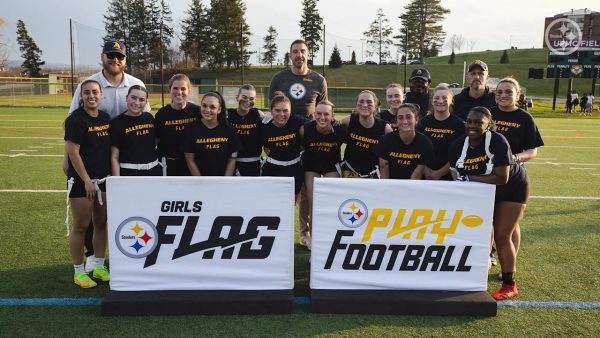Students design art project to share campus stories
Two Allegheny art courses debuted a semester-long project on Wednesday, Dec. 6, in the Gator Quad. The project will run until Sunday, Dec. 10. Faculty and students worked with the Jewish and Muslim communities on campus to create the project.
The art installation was the product of two Allegheny courses. River Branch, associate professor of communication arts and theater, and Byron Rich, assistant professor of digital art and painting, paired their Community-Based Media: Creative Citizenry Through Visual Media and Electronic and Intermediate Art classes to develop the installation.
The project features a domed structure with four smaller structures on paths radiating out from the center. Inside the dome, projectors display video narratives from Muslim and Jewish students on campus, as well as scenes of important rituals from each community. Each day showcases a different narrative, though all will run simultaneously on Sunday, Dec. 10.
The side paths extend the project in various ways. One path provides historical context for the project. A second allows observers to taste traditional food from one of the communities. A third displays portraits of members of the Allegheny Jewish and Muslim communities alongside quotations.
A fourth path contains two layers. One consists of a television showing people from Allegheny reciting the statement of community. Another offers prompts for people to respond to about the project.
“It’s a way to extend the project, so when you come into it, they’re additive layers,” Branch said.
Branch said she hopes this layer allows people to think about the college’s statement of community, especially its limitations and how it can be improved.
“Our statement of community has a lot about confronting and challenging,” Branch said. “So in other words, it’s primary emphasis is on reacting, and as we began to work more directly with the statement of community, one of my pieces of consideration is how do we also move that statement of community into something that’s more proactive, where there’s a more proactive call to each of us to foster a community in which everyone’s invited to thrive.”
Branch said the project focused on the Jewish and Muslim communities because she felt they were especially impacted by current political events in the United States.
“There was no way to take on a project that worked with all communities feeling [targeted],” Branch said. “So I decided to focus on religious communities that have been historically marginalized and targeted in the United States, and religious communities that are being marginalized right now in the contemporary framework.”
Branch said in previous years, her class worked on off-campus projects. However, after witnessing how the nationally polarized political rhetoric started impacting campus discussions, Branch decided to have her class work on an on-campus project.
“My concern is that if we can’t speak across difference, and we can’t really listen and hear and understand across difference while being passionately engaged, if we can’t do that, then we’re not going to succeed moving beyond campus,” Branch said.
Branch said sharing the stories for the project helped bring people together.
“The hope is really that we can get to a better place of listening,” Branch said. “We’re losing sight of some of the lived impact of our political rhetoric, and I think we need to better see and understand that impact, and to better respond.”
Branch said the project tries to explore the diversity of communities while still identifying unifying themes in the stories.
“One of the challenges of the project is to honor the singularity of each community, and also honor the fact that within each community are a vast array of stories and experiences,” Branch said. “Everyone’s connection to the community is different, and that’s a really important thing we tried to negotiate, and we’ve tried to make explicit within the narrative.”
Alex Hasapis, ’19, said he was aware of the magnitude of the project. He felt one of the biggest challenges was ensuring the end product told the stories how the students intended.
“These two communities, along with so many other communities in our world, are facing highly politicized rhetoric, and have historically faced highly politicized rhetoric,” Hasapis said. “But it seems in today’s day and age, that political rhetoric is finding its way into the news and into our communities, more than we’d like. And trying to share this installation is something that we hope sparks conversation and dialogue through our community. That way, maybe we can come together and learn from one another.”
Hasapis said he felt the mission of the project was to initiate dialogue, both on campus and in the wider community.
“What we’re trying to do as a class is to spark conversation and dialogue within our community and beyond,” Hasapis said. “That way we can learn from one another, together, in a shared setting that allows us to listen to the narratives, and the history, and the contemporary contexts that are going on.”
Cassie Brown, ’20, stopped by to look at the installation.
“I have seen it being put up for a while,” Brown said. “Also, my Judaism professor [Assistant Professor of Religious Studies and Director of Jewish Life Adrienne Krone] mentioned it, so I thought I’d check it out.”
Brown found the stories shared in the dome to be the most impactful part of the project.
“I’m shocked that they were actually able to get that information from people,” Brown said.
For Branch, one of the most important features of the project is the way that it explores the diversity of the communities while still finding central ideas which are relevant for consideration.
“We tried coming up with a multitude of stories while still finding ideas that it’s worth all of us to consider,” Branch said.








